Recent Fire Damage Posts
How many chargers do you have?
5/23/2023 (Permalink)
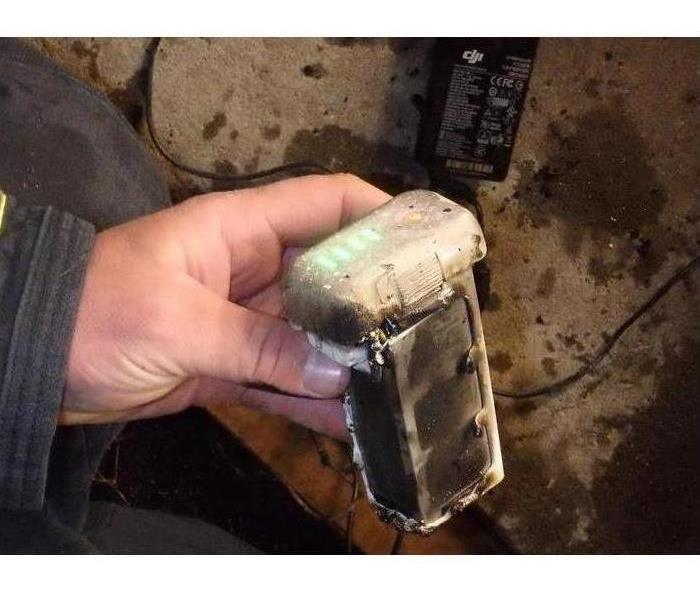 This shows that the charger started on fire.
This shows that the charger started on fire.
How many chargers do you currently have plugged in at your home or office? Between phone chargers, tablet chargers, and various gaming console accessories, it's not uncommon to have several plugged in simultaneously.
But did you know that even when your devices are not connected and actively charging, the wall plugs for these chargers still have power running through them?
While it's widely known that charging a phone on a flammable surface like a bed or sofa can be a fire hazard, many people are unaware that once the phone or charging cord is disconnected, the wall plug continues to draw power.
With the increasing use of mobile electronics in our daily lives, most of us have multiple chargers for our cell phones, tablets, and other accessories. It's common to leave these chargers plugged in and simply disconnect the devices when not in use. However, this practice poses a significant fire hazard and has become one of the leading causes of electrical fires in homes.
To mitigate this risk, there are two preventative measures you can take. One option is to unplug all chargers when they are not actively charging devices. Alternatively, you can plug all chargers into a high-quality GFI power strip and turn it off when the chargers are not in use.
By following these safety precautions, you can reduce the chances of a dangerous and costly fire in your home or business. And in the unfortunate event of a fire or water damage, please remember that SERVPRO of Dubuque is here to help. We specialize in restoring properties to their pre-damaged condition and making it "Like it never even happened."
Fires, Smoke, Soot
5/23/2023 (Permalink)
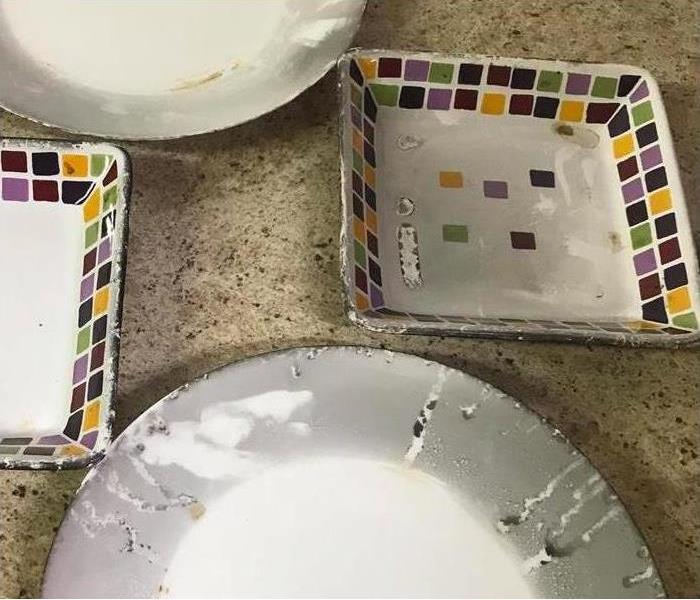 These dishes were in a kitchen fire and were salvageable.
These dishes were in a kitchen fire and were salvageable.
Fires, whether in residential or commercial settings, can result in smoke, soot, and odor that can penetrate various areas of a building, causing hidden damage. At SERVPRO of Dubuque, we specialize in smoke and soot damage restoration. Our expertise allows us to inspect the affected areas, accurately assess the extent of the damage, and develop a comprehensive plan of action for restoration.
Smoke, soot, and odor behavior:
- Hot smoke tends to rise to upper levels of a structure and is also attracted to cooler surfaces.
- Smoke can flow through the home, permeating cavities and using openings such as pipe and electrical runs to travel between floors.
- The restoration process can be influenced by the type of smoke and soot present.
- The approach to eliminating odors may vary depending on the specific type of smoke.
Different types of smoke:
There are two main types of smoke: wet smoke and dry smoke. The type of smoke determines the characteristics of the soot residue left behind after a fire. Before initiating restoration, our team at SERVPRO of Dubuque can perform pretesting to identify the type of smoke involved. This information helps us plan and implement the most effective cleaning procedures.
- Wet Smoke (Plastic and Rubber): This type of smoke results from low heat, smoldering fires and produces a pungent odor. Soot from wet smoke tends to migrate horizontally, is sticky, and smears easily. Cleaning smoke webs can be more challenging.
- Dry Smoke (Paper and Wood): Dry smoke is generated by fast-burning fires with high temperatures. Heat rises, causing the smoke to ascend. Dry smoke produces lighter soot that is less likely to be sticky or smear.
Smoke odor removal:
In addition to the physical cleaning process, SERVPRO of Dubuque utilizes various specialized machines to mitigate smoke odors. Examples of these machines include ozone machines, hydroxyl machines, and HEPA air filtration devices with activated carbon/charcoal filters.
Our fire damage restoration services:
Each fire loss is unique and requires a customized solution tailored to the specific conditions. SERVPRO of Dubuque is equipped with the necessary equipment, expertise, and experience to restore your property after fire, smoke, and soot damage. We prioritize treating your family with empathy and respect while caring for your property.
If you experience a fire, smoke, or soot-related loss, reach out to the fire damage professionals at SERVPRO of Dubuque. We are committed to ensuring that the restoration process makes it "Like it never even happened."
Different Classes of Fires
5/23/2023 (Permalink)
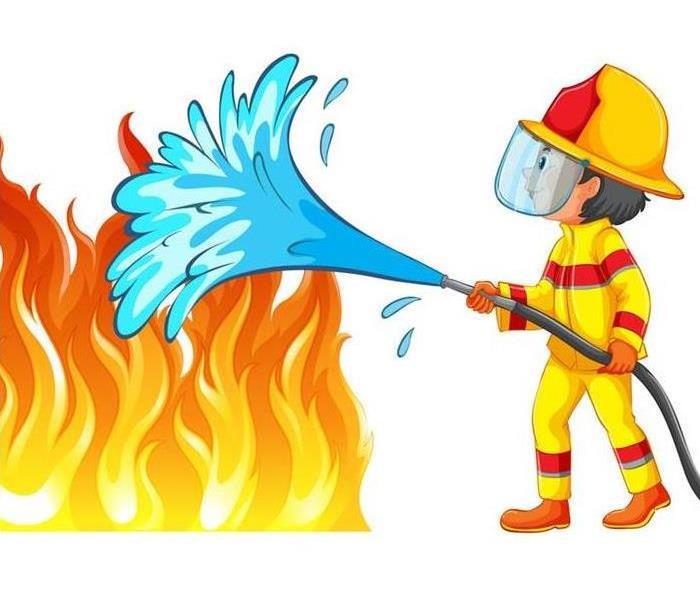 A-F tells you what fire class products start and how to put them out.
A-F tells you what fire class products start and how to put them out.
Fires can be classified into different categories based on the materials involved, providing valuable information about their causes and behavior. Here are the various classes of fires:
Class A - Fires involving solid materials like wood, paper, or textiles. These materials absorb energy from external ignition sources and can ignite through conduction, convection, radiation, or internal heat-producing processes.
Class B - Fires involving flammable liquids such as petrol, diesel, or oils. Using water extinguishers on flammable liquid fires is not recommended as it can spread the liquid and worsen the situation. Water extinguishers are suitable for environments with large amounts of combustible materials, like warehouses or storage facilities.
Class C - Fires involving gases. These fires occur when a flammable or combustible material, combined with an oxidizer like oxygen, is exposed to heat or a temperature above the fuel's flashpoint.
Class D - Fires involving metals. During a fire, the mechanical properties of steel can deteriorate under high temperatures. Structural steel members may deform, but they regain their pre-fire properties after the fire is extinguished.
Class E - Fires involving live electrical apparatus. Although not technically recognized as 'Class E,' this term is used for convenience. Faulty electrical outlets, old appliances, or faulty cords, receptacles, and switches can cause electrical fires.
Class F - Fires involving grease. Grease fires occur when cooking oil becomes too hot, reaching its smoking point and eventually catching fire. Most vegetable oils have a smoking point around 450°F, while animal fats like lard or goose fat will start smoking around 375°F.
In the event of a fire and requiring emergency services, please contact SERVPRO of Dubuque. Our dedicated team will swiftly respond to make the situation "Like it never even happened."
Make an Escape Plan
5/23/2023 (Permalink)
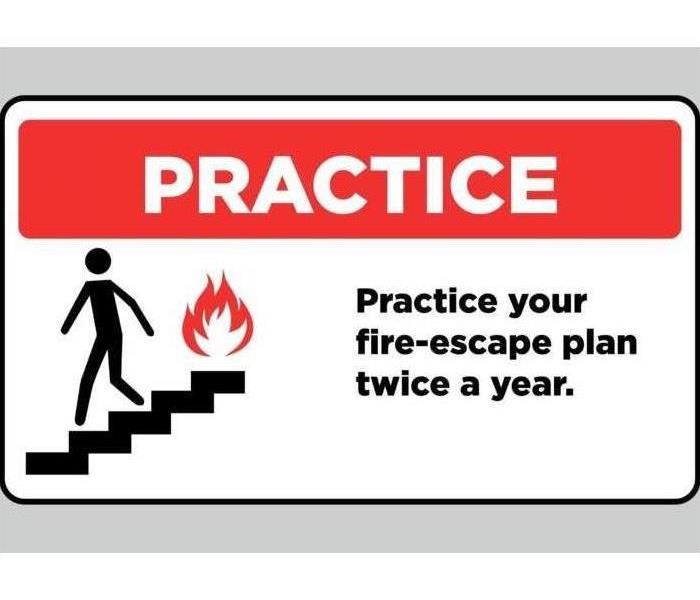 Reminding everyone to practice a fire escape twice a year.
Reminding everyone to practice a fire escape twice a year.
Creating an effective escape plan is crucial in the event of a home fire, as a fire can spread rapidly, allowing only a short window of time to escape. Follow these guidelines from the NFPA and use the provided steps to develop and practice your home fire escape plan:
Draw a map of your home:
- Identify all possible escape routes from each room.
- Ensure that doors and windows leading outside can be easily opened.
- Consider alternative routes, such as windows onto adjacent roofs or collapsible ladders for upper-story windows.
- If you live in a multi-story building, plan to use the stairs instead of the elevator.
Designate a meeting place:
- Choose a safe location outside the house where everyone should gather after escaping.
- Make sure the meeting place is a sufficient distance away from the house to avoid potential hazards.
Practice your home fire escape plan:
- It's crucial that everyone in the household, including children, is familiar with the escape plan.
- The National Fire Protection Association recommends practicing the fire drill at least twice a year, both during the day and at night.
During the practice drills, remember to:
- Practice escaping with your eyes closed to simulate low visibility, crawling low to the floor, and covering your mouth.
- Emphasize the importance of closing doors behind you to slow down the spread of fire and smoke.
- Teach everyone the "stop, drop, and roll" technique in case their clothes catch fire.
- Practice testing door handles before opening them to determine if they are hot.
- Educate children to never hide during a fire and teach them how to escape on their own if necessary.
By developing and regularly practicing your home fire escape plan, you can ensure that everyone in your household knows what to do in case of a fire, increasing the chances of a safe and successful escape.
Ensuring your Family's Safety
5/23/2023 (Permalink)
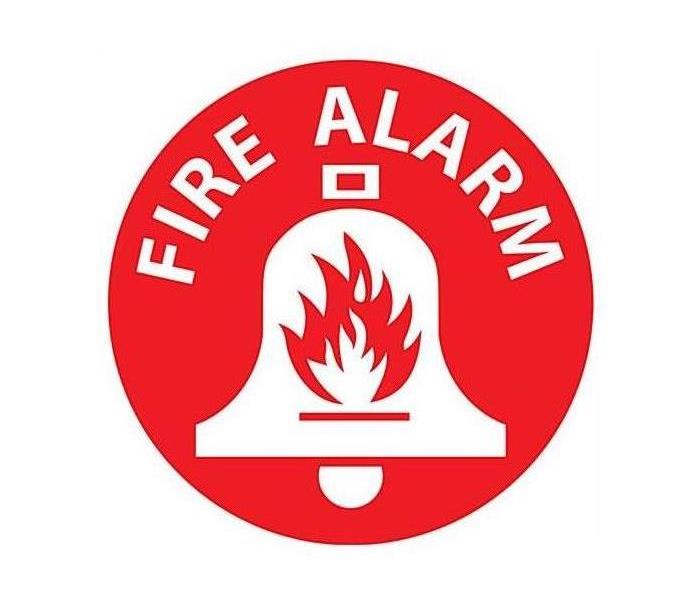 Having working fire alarms helps ensure you and your family's safety.
Having working fire alarms helps ensure you and your family's safety.
With cooking and heating being the leading causes of home fires and fire injuries, it's essential to prioritize fire safety, especially during the winter months. Review and practice the following fire safety tips to ensure a safe environment:
Cooking Safety:
- Stay alert and avoid using the oven or stovetop if you're sleepy or under the influence of alcohol.
- Always remain in the kitchen while frying, grilling, boiling, or broiling food.
- When simmering, baking, or roasting, check the food regularly and use a timer. Don't leave the kitchen unattended.
- Keep flammable items away from the stovetop to prevent fire hazards.
Heating Safety:
- Keep flammable materials, such as paper, clothing, bedding, drapes, or rugs, at least three feet away from space heaters, stoves, or fireplaces.
- Never leave portable heaters or fireplaces unattended. Ensure that heaters are turned off, and fireplace embers are extinguished before leaving the room.
- Place space heaters on a non-flammable surface, like ceramic tile, and keep them away from rugs or carpets.
- Keep children and pets away from space heaters.
- When purchasing a space heater, choose models with automatic shut-off features if they tip over.
Additional Fire Prevention Measures:
- Enforce a "no smoking" policy in your home.
- Regularly inspect cords and replace any that are frayed or have exposed wires.
- Consider using flameless candles as a safer alternative.
- Store matches and lighters in a locked cabinet, out of reach of children.
Smoke Alarm Importance:
- Install smoke alarms on every level of your home, including inside bedrooms and outside sleeping areas. Mount them on ceilings or high on walls.
- Place smoke alarms at least 10 feet away from the kitchen to reduce false alarms.
- Utilize special alarms with strobe lights and bed shakers for individuals who are hard of hearing or deaf.
- Test smoke alarms monthly and replace batteries annually. Change the batteries in your carbon monoxide detector simultaneously.
- Replace smoke alarms that are 10 years old or older to ensure proper functionality.
By following these fire safety guidelines and making them a part of your routine, you can significantly reduce the risk of fire incidents and enhance the safety of your home and loved ones.
Family Emergency Plan - Fire Escape Plan
5/23/2023 (Permalink)
Having a Family Fire Escape Plan is crucial for every household to ensure the safety of all family members in the event of a fire. It's important to have a plan in place and for everyone to be familiar with it. Here are the key steps to include in your plan:
- Ensure that all smoke detectors in your home are working properly and regularly tested.
- Establish a designated meeting spot outside the house where the family will gather in case of a fire.
- Determine and communicate the escape routes from different areas of the house. Everyone should know the quickest and safest way to exit each room.
- Teach children how to escape safely, emphasizing the importance of avoiding hot surfaces or touching anything that feels warm during a fire.
- Keep all passageways clear and unobstructed, allowing for easy access to escape routes.
- Practice the escape plan with your children at least twice a year. This helps familiarize everyone with the process and ensures a quicker response in an emergency.
- Remind family members to never go back into the house once they have safely escaped. It's crucial to wait for firefighters to arrive and handle the situation.
At SERVPRO of Dubuque, we sincerely hope that you and your family never experience the tragedy of a fire in your home. However, if such an unfortunate event occurs, we encourage you to rely on our highly-trained fire and water damage specialists. We are here to support you and help restore your home, making it look "Like it never even happened."
Key Elements of a Fire?
5/22/2023 (Permalink)
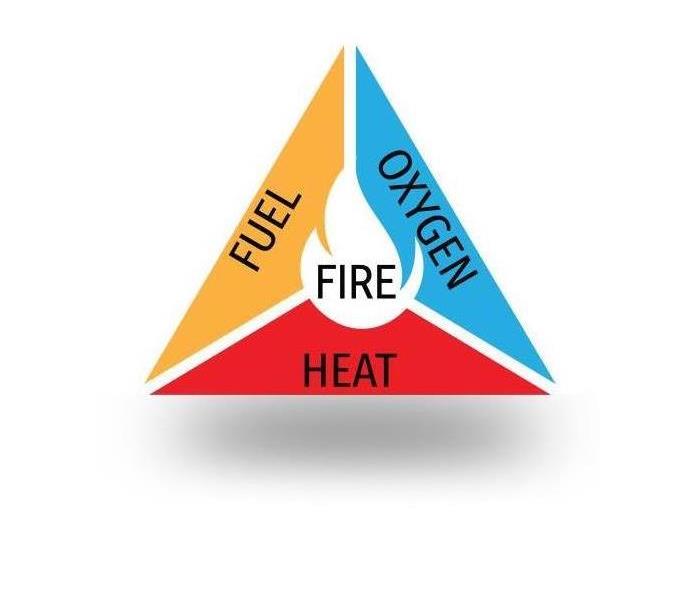 Heat, Fuel, Oxygen
Heat, Fuel, Oxygen
In order for a fire to start and spread, three elements are essential: heat, oxygen, and fuel. To effectively prevent fires, it is crucial to address one or more of these elements. Conducting a comprehensive risk assessment should include detailed considerations of heat, oxygen, and fuel to minimize the risk of fire initiation and spread.
Fire-prevention programs have specific goals, including fire prevention, fire detection, fire notification, fire suppression, and fire control. Fires can disrupt business activities, lead to loss or damage of important documents, result in employee work hour losses, and potentially give rise to liability claims if the fire spreads to neighboring properties.
Fires can have severe consequences, causing injuries, loss of life, and damage to buildings. By proactively establishing a fire prevention plan, you can help protect your employees and visitors, prevent costly damages, and mitigate the risk of fines or legal action against your business.
This is where an Emergency Ready Plan from SERVPRO of Dubuque becomes crucial. The Ready Plan provides easy access to all your emergency contacts and utility shut-off locations, both in hard copy and digital formats. Additionally, by having a Priority Service Agreement with SERVPRO of Dubuque, you can benefit from our quick response in the event of a fire, helping you get your business back up and running promptly. With our expertise, we strive to make the fire's impact "Like it never even happened."
SERVPRO of Dubuque
563-584-2242
www.SERVPROdubuque.com
A quick call to SERVPRO
5/22/2023 (Permalink)
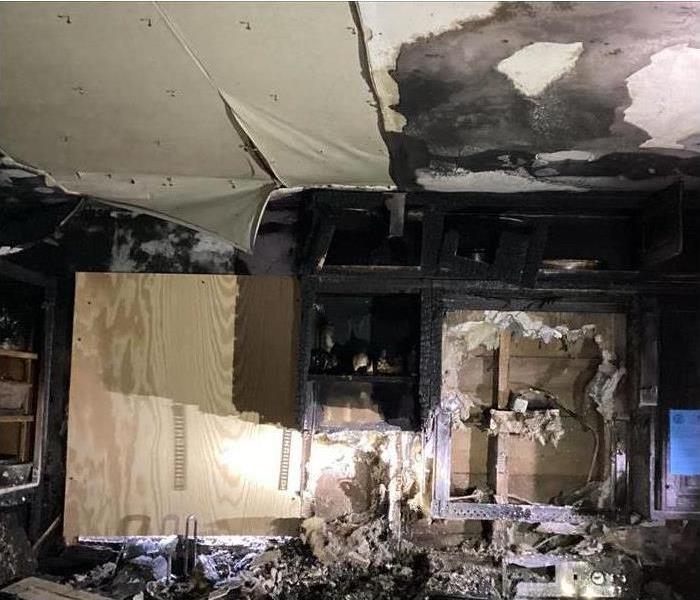 Kitchen fire in Platteville, WI.
Kitchen fire in Platteville, WI.
Having just experienced a fire, you find yourself facing the aftermath once the firetrucks and emergency responders have departed. In this overwhelming situation, a simple call to SERVPRO of Dubuque can provide you with the assistance you need. Their team will swiftly arrive to secure your home and assess the extent of the damage, developing a comprehensive plan to restore your home to its pre-fire condition.
In addition to the visible damage caused by the fire, your home is also saturated from the firefighting efforts. The combination of fire and water damage can be devastating. Furthermore, the presence of smoke and soot poses a potential health hazard as it permeates every corner of your home. Even if the fire was contained to a small area, the smoke and soot can infiltrate throughout the entire property.
With SERVPRO of Dubuque's team of highly-trained professionals, you can trust in their expertise, knowledge, and specialized tools to effectively address fire and smoke damage. They prioritize safety by utilizing appropriate personal protective equipment during the cleaning process and ensuring the complete removal of odors.
SERVPRO of Dubuque's ultimate goal is to restore your home and belongings to their pre-fire state, leaving no trace of the incident. Their dedication to quality and their commitment to delivering exceptional results will help you overcome this challenging situation, making your home "Like it never even happened."
Faster to any Size DisasterSERVPRO of Dubuque
563-584-2242
www.SERVPROdubuque.com
You’ve had a fire. What do you do next?
5/22/2023 (Permalink)
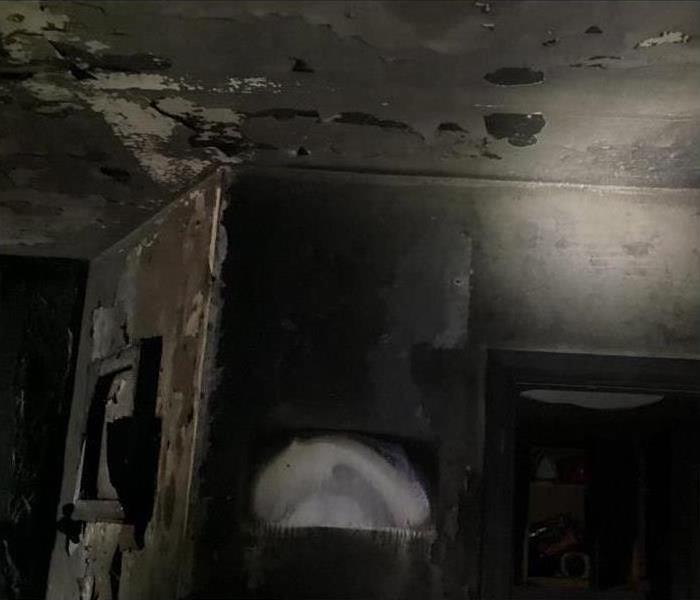 This photo shows a kitchen that caught on fire.
This photo shows a kitchen that caught on fire.
In the unfortunate event of a fire, it is crucial to find professionals who can secure the damaged area, remove property, and extract water used for extinguishing the flames. However, this is only the beginning of the journey to restore your home and belongings to their pre-fire condition.
SERVPRO of Dubuque understands the urgency and promptly responds to secure your property once the fire is extinguished. With the aid of high-quality commercial-grade water extraction equipment, desiccant dehumidifiers, and air movers, we swiftly extract the residual water. This step is essential as moisture left behind can lead to mold growth, causing further damage and expensive remediation. Our team also carefully removes damaged property, meticulously documenting each item with photos to be cleaned and restored. Any items beyond restoration are properly disposed of. We go the extra mile by laundering clothes and draperies, shampooing upholstered furniture, and thoroughly wiping down toys to restore your property. Additionally, we offer the service of freezing important documents, which are then shipped to our trusted affiliates for proper drying and preservation.
Once the water extraction and property removal are completed, we proceed to remove the damaged areas of your home to prepare for thorough cleaning. Our team has the capability to utilize techniques like garnet or soda blasting to effectively clean areas stained by smoke or soot. We also seal affected areas to prevent lingering odors, potentially saving on reconstruction costs.
Throughout the entire restoration process, our highly trained technicians will keep you well-informed, ensuring you are aware of each step taken to make your home "Like it never happened."
This is just a brief overview of the comprehensive services provided by SERVPRO of Dubuque in the unfortunate event of a fire.
Faster to any size disaster
SERVPRO of Dubuque
563-584-2242
www.SERVPROdubuque.com
Fire, Fire, Fire
5/22/2023 (Permalink)
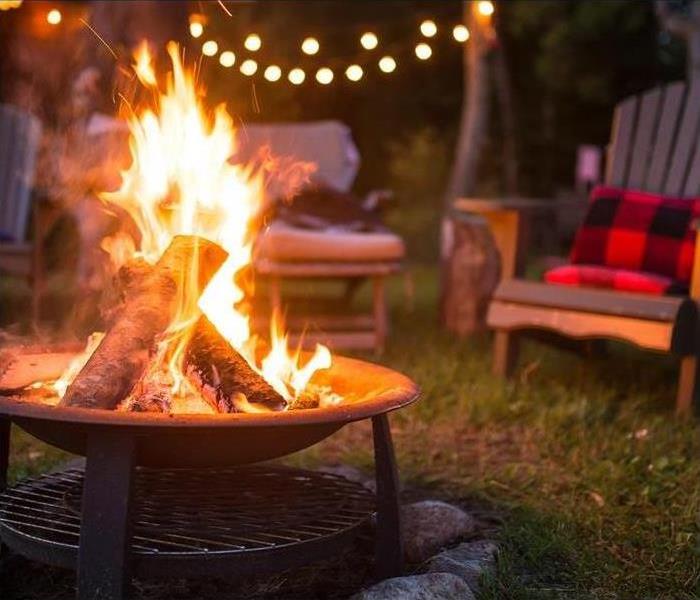 Enjoying a nice warm bon fire.
Enjoying a nice warm bon fire.
With fall coming to a close and winter on the way SERVPRO of Dubuque would like to remind everyone that even though it’s outside the traditional “fire season” don’t take fire safety lightly. Because we know you hardy Midwesterners will still be using your fire pits well into winter.
Check the wind conditions! Before you start up a blaze in your fire pit, check the local weather forecast. Don't use your fire pit on unusually windy days, as the wind can make it hard to light the kindling and could blow sparks to surrounding brush or structures, potentially starting a fire. Also, always check the direction of the wind before you start your fire.
Make sure your fire pit is in the open! Never light your fire pit when it's underneath the overhang of a building or beneath trees, and keep the immediate area around the pit clear of yard waste and other flammable materials. Wayward sparks can blow out of the fire and ignite nearby structures, dry wood, leaves, or other debris, and you could end up with a fire emergency.
Never burn construction lumber! Always use aged hardwood, it will give off less smoke and ash.
Be ready to extinguish your fire! Your fire will attract people to its warmth and light giving your outdoor gatherings a little joy and romance. But it can also be an unpredictable, destructive force. If you've set your fire pit in a safe location you probably won't encounter any serious problems. But you should always keep a shovel and water at hand, just in case. In an emergency, you can use the water to quench the fire and the shovel to smother the flames by throwing dirt on them. You may also want to invest in a fire blanket, which can be used to smother a blaze in or outside the fire pit.
Never leave a fire unattended! Even after a fire has died down and only glowing embers remain, do not leave it unattended. Tiny flames and glowing embers may seem innocuous, they're still a potential threat to your safety. Pour water over live embers, and turn logs to make sure all sides of the wood have stopped burning before you call it a night.
Drink responsibly! Fire and alcohol don't mix. Not only is alcohol flammable, but overindulgence in alcohol impairs coordination, judgment, and reflexes. Keep your guests a safe distance from the flames, and be ready to douse the fire in case of any alcohol-induced mishaps
Obey no-burn alerts when issued for your area! When drought, weather conditions or when air pollution causes an increase fine particulate pollution to an unhealthy level. No-burn alerts may be issued to protect local air quality. Noncompliance with a no-burn order not only puts your community's health at risk, but could also result in fines. Before you light your fire pit, check to see if there's a no-burn advisory in effect.
Faster to any size Disaster
SERVPRO of Dubuque
563-584-2242
www.SERVPROdubuque.com
Fires, what causes them and what you can do to protect yourself and loved ones
5/22/2023 (Permalink)
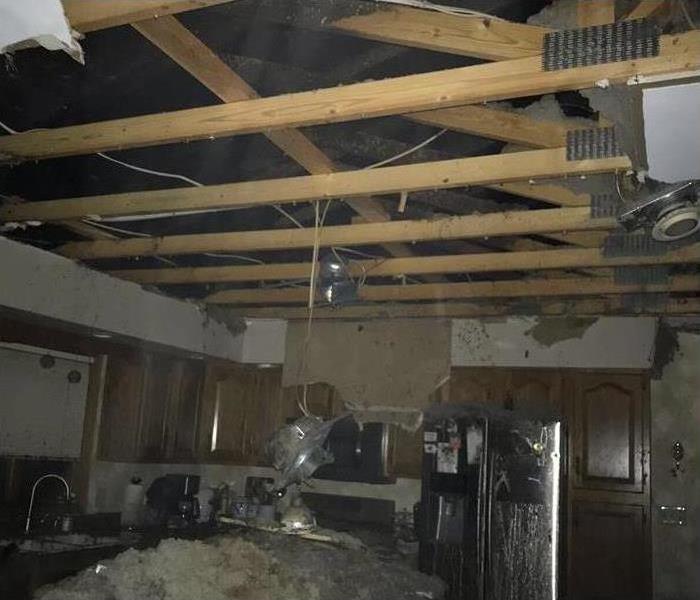 This shows a fire in a kitchen in Dubuque, Iowa.
This shows a fire in a kitchen in Dubuque, Iowa.
The following data is from the National fire Protection Association
Cooking was the leading cause of reported home fires and home fire injuries in 2015-2019 and the second leading cause of home fire deaths. Cooking caused 49 percent of reported home fires, 20 percent of reported home fire deaths, and 42 percent of home fire injuries
Heating Equipment is the second leading cause of home fires and home fire injuries, and the third leading cause of home fire deaths. Local fire departments responded to an estimated average of 48,530 fires involving heating equipment per year in 2014-2018, accounting for 14% of all reported home fires during this time. These fires resulted in annual losses of 500 civilian deaths, 1,350 civilian injuries, and $1.1 billion in direct property damage.
Electrical Fires, To help reduce your risk, NFPA and ESFI recommend that you have all electrical work done by a qualified electrician, including electrical inspections, when buying or remodeling a home. In the video below,
Candles, from 2015-2019 U.S. fire departments responded to an estimated 7,400 home structure fires that were started by candles per year. These fires caused an annual average of 90 deaths, 670 injuries and $291 million in direct property damage.
Smoking materials, including cigarettes, pipes, and cigars, started an estimated 17,200 home structure fires reported to U.S. fire departments in 2014. These fires caused 570 deaths, 1,140 injuries and $426 million in direct property damage. Smoking materials caused 5% of reported home fires, 21% of home fire deaths, 10% of home fire injuries, and 6% of the direct property damage.
Some fire safety tips
Unplug items when not in use
Things like computers, TVs, game systems and a whole lot more use electricity even when they’re not on. That means they can always experience a surge or they can just overheat and cause a fire.
Use Surge Protectors
A surge in power is when you are most likely to experience an electrical fire and by plugging items into a surge protector you don’t have to worry about that excess electricity getting to the item and causing a fire.
Never Leave Flames Unattended
If you’re cooking or lighting candles, you want to make sure that you’re watching it at all times. If you start cooking anything, you never want to walk away from the stove. Keep dish cloths and anything combustible away from the stove. If you start a fire in your fireplace you want to make sure you keep an eye on that as well. Keeping a fire extinguisher in the kitchen or near the fireplace is a very good idea. Make sure all of the adults in the home know how to properly use the extinguisher.
Don’t Smoke in the Home
If you do smoke, it’s important to always do so in a well-ventilated area and to completely put out the cigarette before you throw it away. My father when he smoked in the house would always run water over the butt before throwing it away. Cigarettes have a variety of additives and materials inside of them that can continue to burn even if you think that you’ve put them out.
Remove Lint and Change Filters
Your heating system needs a filter in order to run, but how often do you change out that filter? You need to be doing it frequently because if lint fills up that filter the heat from the furnace can actually ignite it.
This is true for your dryer as well. You want to make sure that you remove the lint from your dryer filter every time that you do the laundry. Even a small amount of lint could cause a huge fire.
Space Heaters
Turn off space heaters when you leave the room including electric fireplaces. Make sure you only use heaters that automatically turn off if they tip over.
Reduce the Clutter
Cluttered home can enable a fire to spread more quickly.
Store Oils and Gases Away from Flames And Sparks
This would include keeping cooking oils away from the stove and store gas and flammables in approved containers and away from open flames such as pilot lights.
Have your Furnace Tuned up annually
An HVAC professional can make sure that your furnace is going to keep working the right way and that it’s not going to put you in any danger of fire.
Remember should the worst happen and you do have a fire
SERVPRO of Dubuque
Faster to any size Disaster
563-584-2242
SERVPROdubuque.com
Fireplace Safety
5/22/2023 (Permalink)
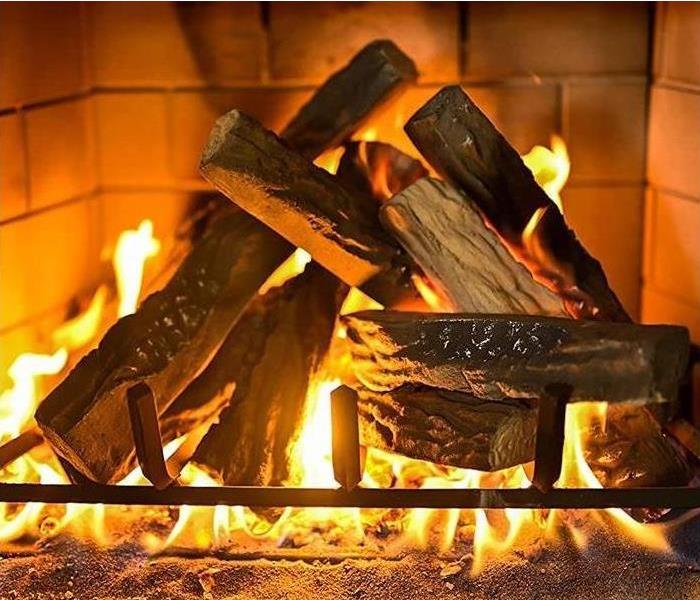 Fire place in a home.
Fire place in a home.
As the chill of winter sets in, it's time to cozy up by the fireplace or wood stove. To ensure your fire stays safely contained, let's review some important guidelines:
- If possible, keep a window cracked open while the fire is burning.
- Always ensure the damper or flue is open before starting a fire. Keep it open until the fire is completely extinguished to draw smoke out of the house. Never close the damper until the embers have stopped burning.
- Avoid using your fireplace as the primary source of heating for your home, and don't let the fire burn for more than five hours at a time.
- Use dry and well-aged wood for a cleaner burn. Wet or green wood can lead to soot buildup in the chimney and increase the risk of a chimney fire.
- Burn smaller pieces of wood on a grate for faster burning and less smoke production.
- Regularly clean out ashes from previous fires, keeping the ash level at the base of the fireplace to 1 inch or less. Excessive ash restricts air supply and results in more smoke.
- Schedule an annual professional inspection of your chimney to ensure its safety and proper functioning.
- Install a chimney cap to prevent water damage, blockages caused by debris, and nesting of animals. Consider using a spark arrestor to minimize the risk of sparks igniting fires on the roof or lawn.
- Take precautions to prevent burns from the hot glass front of some fireplaces, especially for children. Install safety screens to reduce the risk of contact with the hot surface.
- Keep the area around the fireplace clear of flammable items such as furniture, drapes, newspapers, and books.
- Never leave a fire in the fireplace unattended. Make sure it is fully extinguished before going to bed or leaving the house. If you leave the room while the fire is burning or the fireplace is still hot, ensure your small child accompanies you.
- Store fireplace tools, accessories, lighters, and matches out of reach of young children.
- Install smoke and carbon monoxide detectors throughout your home.
- Have a fire extinguisher readily available in case of emergencies.
- Never allow children to play near or with fire tools, even if adults are present.
- Educate children early about the dangers of fires and the heat emitted by fireplaces.
By diligently practicing fire safety measures, you can keep your family safe and warm. In the unfortunate event of fire or smoke damage, remember that SERVPRO of Dubuque has the expertise and equipment to restore your home to its pre-damaged state, ensuring it's "Like it never even happened."
Fire Fun
5/22/2023 (Permalink)
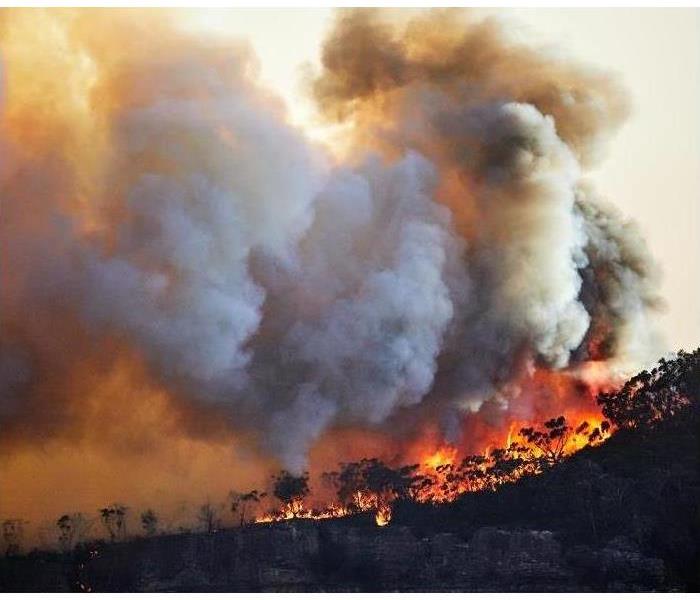 smoke & fire
smoke & fire
Allow me to introduce myself, I am The Fabulous Fernando Flame and along with my wife Sensuous Sally Smoke we can cause an amazing amount of grief into your life. Unless of course you call SERVPRO of Dubuque.
One thing you need to know is even after I’ve been put out by the local Fire Department or someone handy with an extinguisher you still have to deal with my aftermath. Ash and charcoal will need to be removed. Lucky for you SEERVPRO of Dubuque has the Garnet blaster to clean up the mess I’ve left behind. On top of that they have the Desiccant Dehumidifiers and air movers to remove the excess water used to put me out. As for my wife Sally Smoke I’m pretty sure SERVPRO of Dubuque has the air scrubbers that will remove my sensuous wife Sally Smoke from the air and make it "Like it never even happened." Soon I will be posting some tips on how to prevent fires and always remember if you see my wife Sally you should start looking because whenever you see smoke I’m not far behind
Fire Damage
5/15/2023 (Permalink)
There are distinctive training of fires. The instructions inform you a little bit of data on matters that can purpose and begin a fire.
- Class A - fires involving strong substances such as wood, paper or textiles. Most stable substances take up power from any outer ignition supply both with the aid of conduction, convection or radiation (mostly by using their combination), or are heated up as a end result of the heat-producing techniques taking location internally that begin decomposition on their surfaces.
- Class B - fires involving flammable beverages such as petrol, diesel or oils. In the case of a flammable liquid fire, a water extinguisher will unfold the liquid round which can probably do greater damage than desirable and exacerbate the fire. Water extinguishers are endorsed for environments that keep giant quantities of flammable substances such as warehouses, paper mills and storage facilities.
- Class C - fires involving gases, fires begin when a flammable or a flammable material, in aggregate with a ample volume of an oxidizer such as oxygen gasoline or any other oxygen-rich compound (though non-oxygen oxidizers exist), is uncovered to a supply of warmth or ambient temperature above the flash factor for the fuel/oxidizer mix, and is in a position to.
- Class D - fires involving metals. During a fireplace event, the mechanical houses of metal deteriorate beneath the increased temperature. A discount in yield strength, stiffness, and modulus of elasticity can occur. Even if the structural metal participants are deformed, the metal will regain its pre-fire residences as soon as the furnace is extinguished.
- Class E - fires involving stay electrical apparatus. (Technically ‘Class E’ doesn’t exist on the other hand this is used for comfort here) Most electrical fires are precipitated through inaccurate electrical retailers and old, out of date appliances. Other fires are begun by means of faults in equipment cords, receptacles and switches.
- Class F - fires involving grease A grease fireplace takes place when your cooking oil will become too hot. When heating, oils first begin to boil, then they shall begin smoking, and then they will trap on fire. Most vegetable oils have a smoking factor round 450°F, while animal fat like lard or goose fats will begin smoking round 375°F.
If you have a furnace and are in want of emergency offerings, please supply SERVPRO of Dubuque a name and we will be completely satisfied to make it “ like it never even happened”.
Planning a Trip? Here are some simple but helpful TIPS to keep your home safe while away
12/13/2019 (Permalink)
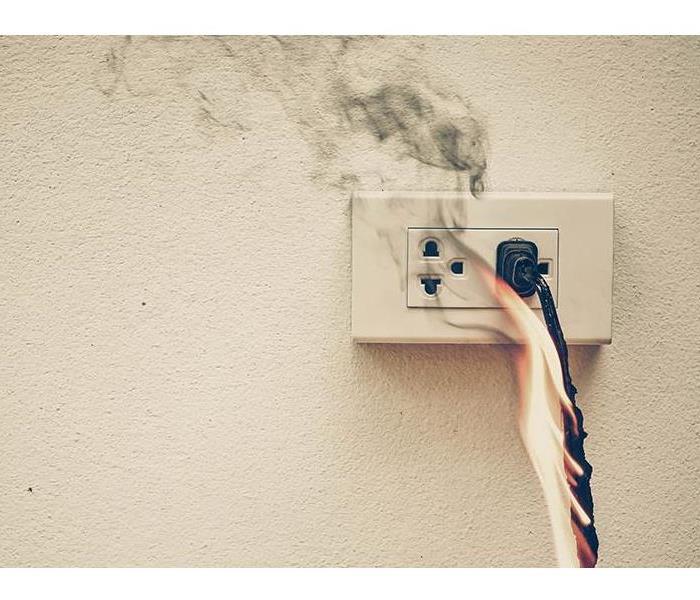 Outlet electrical fire
Outlet electrical fire
The trip has been booked, you have researched the top attractions, recharged your phones, laptop and IPad, packed your suitcases. You’re ready to hit the road.
But wait have you checked your home? Before you depart you should make sure to have your home to-do list completed…
- Turn off your main water supply
Pipes break and even leak even though we are on vacation. Returning home to a flooded house is not anything you want. Weather the trip is a couple days or a couple weeks it is always a good idea to turn the water off.
- Unplug all electronics
This tip has a couple benefits. By unplugging our devises we can prevent an electrical fire from starting and save money on our electric bill, who doesn’t like to save money.
Unplug the major appliances that you don’t need to run while you bask in the sun.
- Invest in a timer
Having lights turn on at different times and in different rooms can prevent a burglar from robbing you.
- Adjust your thermostat
If you live in a place where AC is a must during the summer months, adjust the thermostat a bit to save on your electricity bill. A good rule of thumb is to keep it a few degrees higher than normal. (So if you usually keep it at 70, change it to 75.) By not turning off the AC completely, you’ll keep enough air circulating to control humidity and mold.
If you live where it gets bitterly cold in the winter months you will want to leave the furnace on and lower it to 50-55 degrees to prevent pipes from freezing while away.
- Pour baking soda down your drains and toilet
Coming home to a nasty smell can be prevented by combining some vinegar and baking soda add a cup to your drains for a fresh smell.
- Check up on your insurance
Checking your car, home or renters insurance should be a must. Knowing what our policies cover could save you time and money in the event that something does happen while away.
Also the belongings that you take with you on vacation are covered by your homeowners or renters insurance…who knew.
Bring back the warm weather with you please and thank you, SERVPRO of Dubuque, until next time…
Simple reminders are the best
12/6/2019 (Permalink)
 Christmas Tree Fire
Christmas Tree Fire
Simple reminders are the best
Holiday Safety Tips from your local SERVPRO of Dubuque
Lights, trees, candles and decorations are just a few of the fun and festive items that come to mind during the holiday season – however, if not used properly your holidays may go from merry to miserable.
Although Christmas tree fires are not that common, when they do occur, they are more likely to be serious fires. The American Red Cross offers the following safety tips to greatly reduce the risk of a fire in your home or business.
‘Tis the season to make sure you are following proper safety tips.
- Place Christmas trees, candles and other holiday decorations at least three feet away from heat sources like fireplaces, portable heaters, radiators, heat vents and candles.
- Make sure that light strings and other holiday decorations are in good condition. Do not use anything with frayed electrical cords and always follow the manufacturer’s instructions.
- Always unplug the tree and holiday lights before leaving the property or going to bed.
- Never use lit candles to decorate a tree. Always extinguish candles before leaving the room or going to bed.
- Use only sturdy tree stands designed not to tip over. Keep curious pets and children away from the Christmas tree.
- Keep anything that can catch on fire – pot holders, oven mitts, wooden utensils, paper or plastic bags, food packaging, and towels or curtains – away from your stove top.
- Designate one person to walk around your property to ensure all candles and smoking materials are properly extinguished after guests leave.
What happens if a disaster strikes your home or business during the holidays? Don’t get your tinsel in a tangle; give SERVPRO of Dubuque a call at 563-584-2242. We are on call 24 hours a day, 7 days a week, because we know that disasters cannot wait.
SERVPRO of Dubuque hopes your holidays are safe, merry, and bright!
Family Emergency Plan - Fire Escape Plan
11/27/2019 (Permalink)
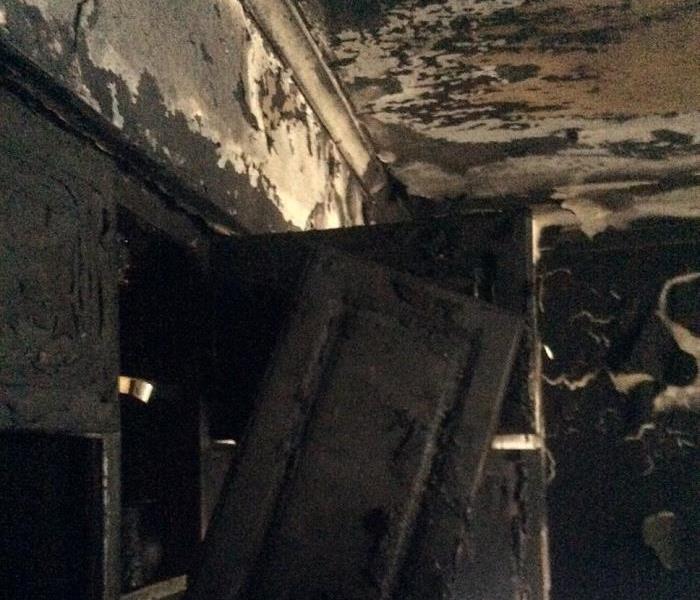 Here is a photo from a residential fire that started in the kitchen. It quickly spread to the stairway leading to the bedrooms
Here is a photo from a residential fire that started in the kitchen. It quickly spread to the stairway leading to the bedrooms
Do you have a Family Emergency Plan for your home?
One of the most important parts of your family's emergency plan should include a Fire Escape Plan.
A Family Fire Escape Plan is crucial to have in place and for every member of the family to be familiar with, before a residential fire occurs. According to experts, people have as little as 2 minutes to escape a burning building before it becomes impossible to get out. Every second counts! In a matter of moments, a small flame can become a major fire, making it critical to be prepared and have an escape plan in place.
In a survey conducted by the American Red Cross, only 26% of families have developed and practiced a home fire escape plan. Once a plan is developed, it is critical the everyone in the home understands the plan. The best way to familiarize the family members with the plan is to practice it at least twice per year.
The following steps can assist in developing and implementing a plan:
- Ensure that all smoke detectors work and have fresh batteries.
- Draw a map of each level of the home, showing all doors and windows
- Consider escape ladders for second floor bedrooms
- Choose an outside meeting place for after you have all escaped
- Teach children how to escape on their own. Have them do so, until they can do so unaided.
- Practice the escape plan during both day and night hours.
SERVPRO of Dubuque hopes that you and your family never have to experience the tragedy of a fire in your home. In the event that it happens, we hope that an escape plan will help to keep your family safe. If you do experience a fire please call on the highly trained fire and water damage specialists at SERVPRO of Dubuque to help make it “Like it never even happened.”
See the difference
11/25/2019 (Permalink)
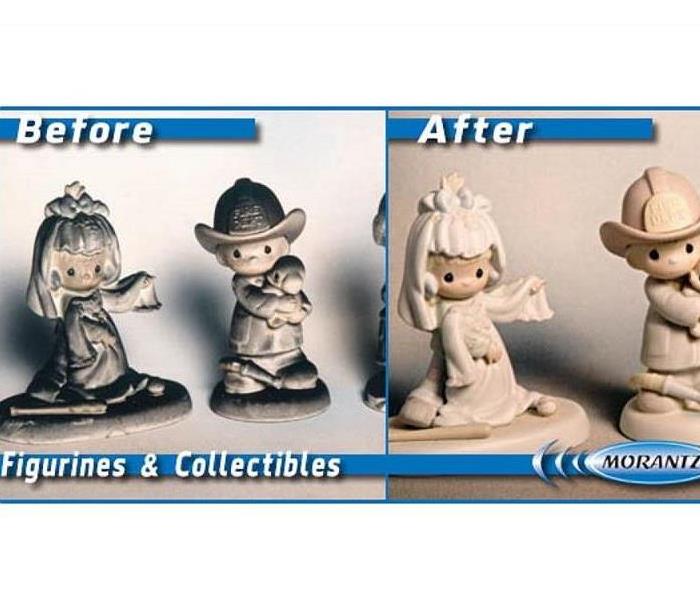 Before & After of a Soot Covered Figurine
Before & After of a Soot Covered Figurine
SERVPRO of Dubuque uses state of the art equipment such as the Ultrasonic Cleaning Machine from Marantz Ultrasonic.
Restoring Smoke, Soot, Water and Mold damaged property is faster, easier and more effective with Ultrasonic than with any other method.
Contents Restoration is an important piece of our business. It not only helps to restore damaged property, it helps restore people’s lives and livelihoods. While property damage can take many forms, what’s important to the owners is that their lives are returned to normal, and that they get their property back, as fast as possible.
Of course, when property can be returned depends on the type and severity of the damage. Certainly not every item, such as those actually burnt or melted in fires, can be restored, but a great number of items that would have traditionally been determined to be unrecoverable can now be quickly restored and returned to the owner with Morantz Ultrasonic.
Benefits of Ultrasonic for Content Restoration
The benefits of restoring property with Ultrasonic are two-fold:
- For Insurance Companies: The cost of restoring an item versus reimbursing the owner for the item’s full value is dramatically diminished. Example: a $1500 television can typically be cleaned and returned to the owner within days. The cost of cleaning that $1500 television for the Insurance could be only $300(or whatever the restoration company decides to charge for their service). This represents a significant savings.
- For Property Owners: They get their original property back quickly. Whereas traditional cleaning methods can take weeks and cause additional property damage, with Ultrasonic most items can be cleaned in as little as 30 seconds to 2 minutes). As a result, it’s no surprise that most people are happy simply getting their property back, especially if it means getting their lives back to normal as quickly as possible and even more so if the items have sentimental value.
Types of Contents Restoration
The damage that occurs to property during fires, floods, accidents and other disasters is often much more severe than it first appears. To be sure, fire itself is destructive and an item that is physically burned or melted cannot be restored. However, property that has been engulfed in smoke, covered in soot, stained or discolored by water or contaminated by chemicals or molds can usually be restored to functional (or even good-as-new) condition with Morantz Ultrasonic.
How Common Damage Occurs
Damage to property and personal possessions can occur in many different ways. While damage as described above is common, fires are particularly troublesome as they can often result in multiple forms of damage. For example:
- During a Fire:Fires can produce vast amounts of smoke that leave soot deposits on property. Depending on what has burned and the temperature of the fire, the soot produced by the fire may not only be mixed with a variety of chemicals and toxins. Additionally, physical properties of the soot can range from a fine powder to a thick sludge. Furthermore, because the particulate matter that makes up soot (and the chemical residue) is microscopic, it can not only penetrate deep into tiny crevices on the surface of an item, but it can also “sink” deep into the item This is especially true of electronics which can actually attract soot and dirt because they can generate magnetic fields or become charged with static electricity.
- Immediately After a Fire:The water that was used to extinguish the flames can discolor the surfaces of many types of items. Additionally, water can cause severe physical damage since the materials from which many items are made can actually absorb surprising amounts of water.
- Long After a Fire:Many types of materials and even the items themselves can retain significant levels of moisture. Moisture absorbed by an item that has not been properly dried, or that remains on or near the surface, may quickly become a breeding ground for molds and bacteria or other potentially hazardous residues (again, depending on what has burned).
Everyday Fire Hazard
11/19/2019 (Permalink)
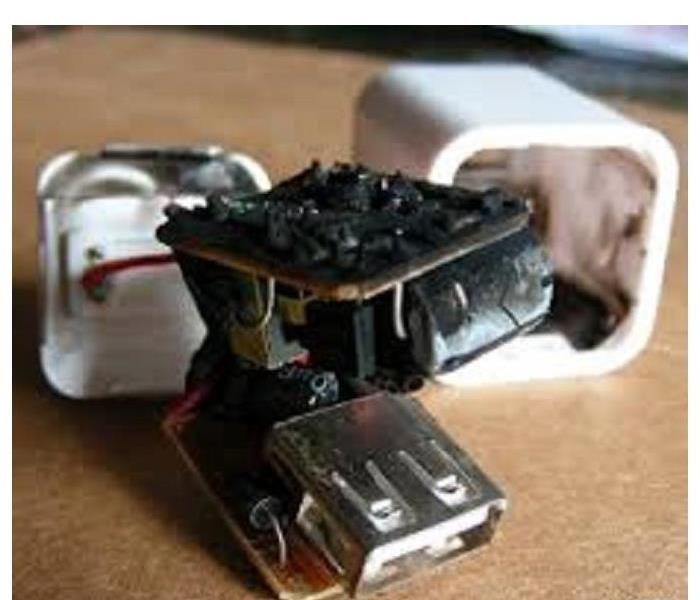 Photo of cell phone charger that overheated, possibly starting a fire.
Photo of cell phone charger that overheated, possibly starting a fire.
As Black Friday approaches, the number of personal electronic devices gracing the coveted Black Friday shopping ads, is astounding.
Almost everyone has multiple electronic devices that they carry on them every day. One of our SERVPRO employees mentioned the other day that their teenage daughter has an iPhone, and iPad, wireless ear buds, an apple watch that she will simply not leave home without. In addition, she has a myriad of other electronic devices in the house or car that are always either plugged in to recharge or are awaiting some juice.
The amount of devices that the average home has either plugged in and charging or the plug and cord are plugged in awaiting a device is simply staggering.
OK, so here comes the scary part.... Each and every one of those plugs and ports is a fire hazard. Most device plugs, especially the really cool ones with LED lights on them, have electricity coursing through them even when a device is not attached.
These are often of inferior or cheap quality and are prone to over heating and shorting out. Hundreds of house fires every year are caused by these plugs and charging ports. Even worse, they are usually tucked behind a piece of furniture or other contents with just the charging cord protruding into the open for easy access. Not to mention the devices that are accidentally left bundled in blankets or under pillows where the heat can build up and increase the chance of a fire.
We are not asking you to skip all the AWESOME Black Friday sales or to pass up the tech device on someone's Christmas list. Just be cognizant of the risks associated with the abundance of charging devices that are in your home. Consider unplugging the plug or port when the device is not being charged.
Happy Shopping from all of us at SERVPRO of Dubuque. We might even put out our Christmas list in an upcoming blog....
Don't Let Winter Weather Take a Toll on You | Part 1
1/31/2017 (Permalink)
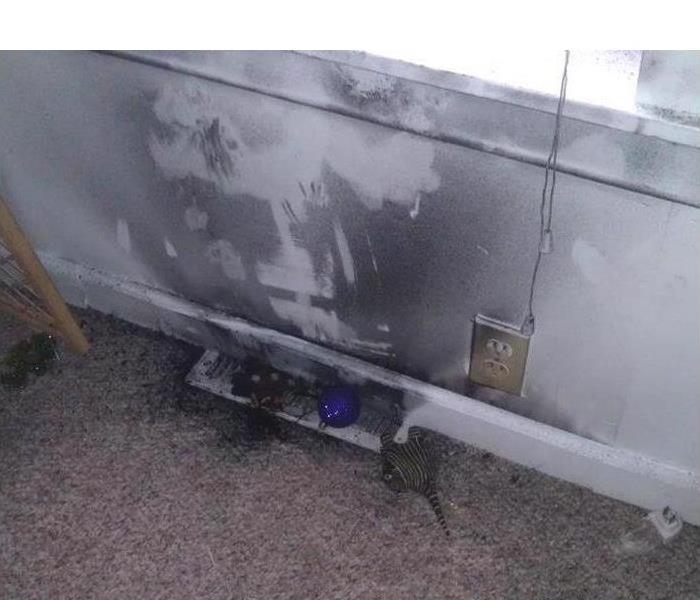 Soot damage to interior walls and carpet from Puff Back in Dubuque Iowa
Soot damage to interior walls and carpet from Puff Back in Dubuque Iowa
The Puff Back Problem - Oil Burning Furnaces
The Problem
A puff back is a messy furnace malfunction that occurs when an oil burner backfires, sending soot throughout your home or business. It can happen all at once, covering the interior in grimy soot, or a puff back can leak soot particles gradually. The soot caused by the Puff Back can do significant damage to both building structure and contents.
Cost of Damage
Minimal to significant depending on the amount of soot released. It also depends on the amount of contents affected by the soot discharge.
Prevention
Consider having your oil burner serviced before you suffer a puff back. If your home or business experiences a puff back, your SERVPRO of Dubuque has the tools, training and experience to help make it “Like it never even happened." We can handle the structural cleaning as well as the contents cleaning. More information about contents cleaning off soot damaged contents can be found in our blog post about using ultrasonic cleaning.






 24/7 Emergency Service
24/7 Emergency Service















